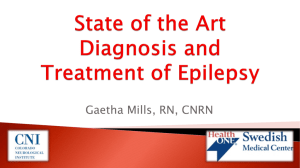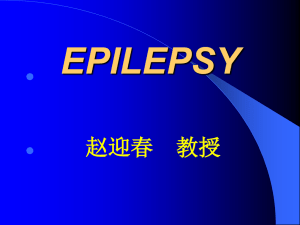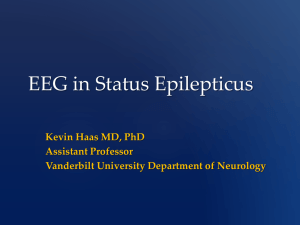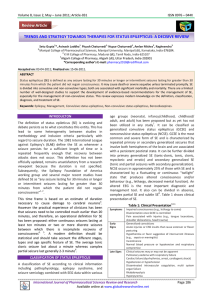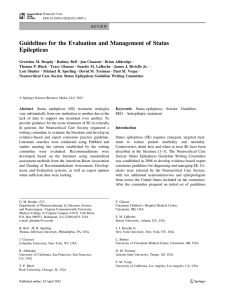Seizures in Childhood-Part Two Treatment of epilepsy
advertisement
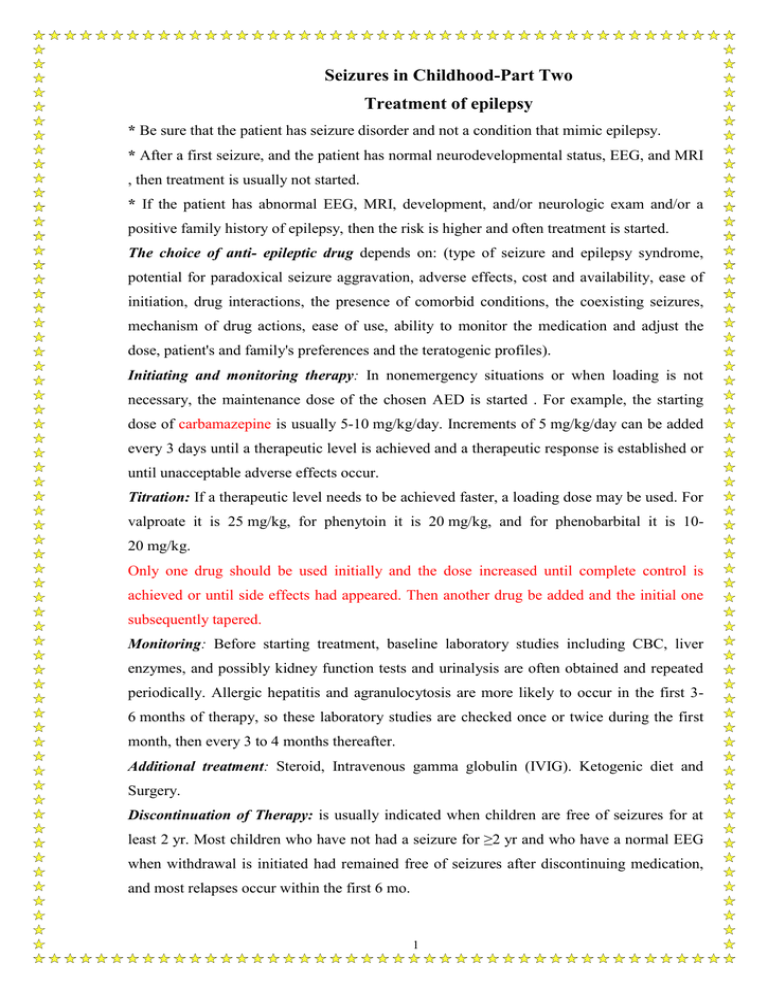
Seizures in Childhood-Part Two Treatment of epilepsy * Be sure that the patient has seizure disorder and not a condition that mimic epilepsy. * After a first seizure, and the patient has normal neurodevelopmental status, EEG, and MRI , then treatment is usually not started. * If the patient has abnormal EEG, MRI, development, and/or neurologic exam and/or a positive family history of epilepsy, then the risk is higher and often treatment is started. The choice of anti- epileptic drug depends on: (type of seizure and epilepsy syndrome, potential for paradoxical seizure aggravation, adverse effects, cost and availability, ease of initiation, drug interactions, the presence of comorbid conditions, the coexisting seizures, mechanism of drug actions, ease of use, ability to monitor the medication and adjust the dose, patient's and family's preferences and the teratogenic profiles). Initiating and monitoring therapy: In nonemergency situations or when loading is not necessary, the maintenance dose of the chosen AED is started . For example, the starting dose of carbamazepine is usually 5-10 mg/kg/day. Increments of 5 mg/kg/day can be added every 3 days until a therapeutic level is achieved and a therapeutic response is established or until unacceptable adverse effects occur. Titration: If a therapeutic level needs to be achieved faster, a loading dose may be used. For valproate it is 25 mg/kg, for phenytoin it is 20 mg/kg, and for phenobarbital it is 1020 mg/kg. Only one drug should be used initially and the dose increased until complete control is achieved or until side effects had appeared. Then another drug be added and the initial one subsequently tapered. Monitoring: Before starting treatment, baseline laboratory studies including CBC, liver enzymes, and possibly kidney function tests and urinalysis are often obtained and repeated periodically. Allergic hepatitis and agranulocytosis are more likely to occur in the first 36 months of therapy, so these laboratory studies are checked once or twice during the first month, then every 3 to 4 months thereafter. Additional treatment: Steroid, Intravenous gamma globulin (IVIG). Ketogenic diet and Surgery. Discontinuation of Therapy: is usually indicated when children are free of seizures for at least 2 yr. Most children who have not had a seizure for ≥2 yr and who have a normal EEG when withdrawal is initiated had remained free of seizures after discontinuing medication, and most relapses occur within the first 6 mo. 1 Risk factors for seizure relapse: • Abnormal EEG before medication is discontinued. • Symptomatic epilepsy. • Absences seizure. • Those who treated with valproate. • Older age of epilepsy onset. • Longer duration of epilepsy. • Presence of multiple seizure types. • Need to use more than one AEDs. Therapy should be discontinued over a period of 3-6 months because abrupt discontinuation can result in withdrawal seizures or status epilepticus. Withdrawal seizures are especially common with phenobarbital and benzodiazepines. Seizures that occur more than 2 - 3 months after AEDs are completely discontinued indicate relapse, and resumption of treatment is usually warranted. Status Epilepticus Continuous seizure activity or recurrent seizure activity without regaining of consciousness lasting for >30 min. Impending Status epilepticus: seizures between 5 and 30 min. Convulsive Status epilepticus: (generalized tonic, clonic, or tonic-clonic), (complex partial, absence), myoclonic status, and neonatal status epilepticus . Nonconvulsive status epilepticus: manifests as a confusional state, dementia, hyperactivity with behavioral problems, fluctuating impairment of consciousness, hallucinations, and psychotic symptoms. Refractory status epilepticus: failure to respond to therapy, usually with at least 2 medications. Etiology: • New-onset epilepsy of any type. • Drug intoxication (tricyclic antidepressants). • Drug and alcohol abuse. • AEDs withdrawal or overdose. • Hypoglycemia, hypocalcemia, hyponatremia, hypomagnesemia. • Acute head trauma. • Encephalitis, meningitis, ischemic stroke, intracranial hemorrhage. • Pyridoxine, and folinic acid dependency. • Inborn errors of metabolism (nonketotic hyperglycinemia) in neonates. • Hypertensive encephalopathy, renal or hepatic encephalopathy. 2 • Brain tumors, brain malformations, and neurodegenerative disorders. Management Continuous attention to ABC (with continuous monitoring of vital signs including ECG). Determination and management of the underlying etiology (e.g., hypoglycemia). Laboratory studies including glucose, sodium, calcium, or other electrolytes, are ordered as routine practice. Blood and spinal fluid cultures, toxic screens, and tests for inborn errors of metabolism are often needed. AED levels need to be determined in known epileptic children already taking these drugs. EEG is often helpful Physical and neurological examination: for any evidence of trauma, papillodema., bulging anterior fontanel, lateralizing neurological signs suggesting ↑ I.C.P., manifestation of sepsis or meningitis, retinal hemorrhage, acidotic breathing and dehydration. evidence of metabolic diseases, constriction or dilatation of pupils. Drugs: should be given by intra venous route. Phenytoin must not be given in glucose solution, because it is precipitated in it. Diazepam : given directly in the vein (0.1-0.3 mg/kg ) with maximum dose of 10 mg at a rate not more than ( 2 mg / min )for max. of 3 doses. It can be used rectally (0.3-0.5 mg/kg ) diluted in 3ml 0.9% NaCl. The drug has short half-life and may cause hypotension and respiratory depression especially if given with barbiturate. Its therapeutic serum level occurs within 5-10 min. Lorazepam: is equally effective with long half- life and less respiratory depression. Its sublingual, I.V and rectal dose ( 0.05 -0.1 mg/kg ). If intravenous access is not available, buccal midazolam or intranasal lorazepam can be used. In infants, a trial of pyridoxine is often warranted. Fosphenytoin: The loading dose is usually 15-20 PE/kg. The maintenance dose can be started right away or, more commonly, in 6 hr. The rate of infusion of fosphenytoin and phenytoin must be not more than 0.5-1 mg/kg/min. The subsequent medication is often phenobarbital, the loading dose in neonates is usually 20 mg/kg, but in infants and children the dose is 5-10 mg/kg .The dose is repeated if there is no adequate response. Intravenous valproate as a third-line medication. 3 After the second or third medication is given, and sometimes before that, the patient might need to be intubated. All patients with, even the ones who respond, need to be admitted to the ICU for completion of therapy and monitoring. For refractory cases, an intravenous bolus of midazolam, propofol, pentobarbital, or thiopental is usually initially used. For non-convulsive status epilepticus: trials of oral or sometimes parenteral AEDs without resorting to barbiturate coma or overmedication that could result in respiratory compromise. Prolonged non-convulsive complex partial status epilepticus can last for as much as 412 weeks, with patients manifesting psychotic symptoms and confusional states. These cases can be resistant to therapy. Some of these cases appear to improve with the use of steroids or IVIG . Potential therapies under study for convulsive status epilepticus include induction of acidosis (e.g., by hypercapnia), and ketogenic diet. Conditions that mimic seizures These conditions share features with epilepsy and may be associated with altered level of consciousness , tonic or clonic movement or cyanosis. Benign paroxysmal vertigo: Typically develops in toddlers. It remits by 5 years of age. The attack develops suddenly associated with ataxia causing the child to fall or refuse to walk or sit. Horizontal nystagmus may occur during the attack. The child appears frightened and pale, nausea and vomiting may be prominent, consciousness and verbalization aren’t disturbed. The attack last (secs – mins) and the frequency vary from daily to monthly; vertigo is verbalized by older child. Those children are susceptible to motion sickness and migraine, negative neurological exam. MRI and EEG are normal, but caloric testing, can show abnormal vestibular function. Treatment: Diphenhydramine (5 mg / Kg / 24 h) → max 300 mg /day (orally ,I.M., I. V., rectally) Night terrors : are common especially in boys between (5-7) y. they occur in (1- 3%) of children and usually short – lived, it start suddenly usually between midnight and 2:00 A.M when the child screams and appears frightened with dilated pupils, tachycardia and hyper ventilation ,there is little or on verbalization and is unaware of surrounding ,sleep follows in few min and there is total amnesia the following morning. 1/3 of them experience somnambulism. Treatment: Short course of diazepam may be considered for protracted cases. Breath – Holding spells : there are 2 major types:4 Cyanotic spells : It is the more common type. Upsetting or scolding an infant provokes it. The attack preceded by brief shrill cry followed by forced expiration and apnea and rapid onset of generalized cyanosis and loss of consciousness which may be associated with repeated generalized clonic jerks , opisthotonus and bradycardia. Interictal EEG is normal. It is rare before 6m of age peaked at 2y and abate by 5y of age. Treatment: Support and reassurance of the parents. Placing the child safely in bed and refusing to cuddle, play or hold the child when recovery is complete because that will reinforce the child behavior. Pallid spells: It is typically initiated by a painful experience or sudden startle, the child stop breathing, rapidly loss consciousness , becomes pale and hypo tonic and may have tonic seizure , normal inter ictal EEG. The attack can be induced spontaneously by ocular compression that produce oculo cardiac reflex , but don’t attempts to do that. Treatment : Conservative, trial of oral atropine sulfate 0.01 mg /kg/day in divided doses with maximum dose of 0.4 mg which will increase the H.R by blocking the vagus nerve.( in refractory cases). Vagal syncope: Vasovagal (neurocardiogenic) is usually triggered by dehydration, heat, standing for a long time without movement. There is initially pallor and sweating followed by blurring of vision, dizziness, nausea, and then gradual collapse with loss of consciousness. Urinary incontinence in 10% and a brief period of convulsive jerks occur in 50%. Postictal confusion can also occur. Abdominal pain, a common aura in temporal lobe epilepsy, occurs in vasovagal syncope. Most children with vasovagal syncope have an affected first-degree relative. EEG is normal and the tilt test has been used for diagnostic purposes. Management: Avoidance of precipitating factors (maintenance of hydration, avoidance of standing still, rising slowly from sitting, first aid measures, raise legs, positioning). Treatment of any accompanying or underlying medical conditions (anemia, adrenal insufficiency, cardiac, etc.). β-blockers or flurohydrocortisone therapy may be needed . Pseudo seizures :- Typically occur between (10 -18) y of age, more frequent in females . It occurs in many patients with past history of epilepsy . No cyanosis, normal reaction of pupils to light , no loss of sphincter control , no tongue biting . The patients are likely to have neurotic personality , no effect for anticonvulsant . EEG shows excess muscle artifact but normal back ground. 5


